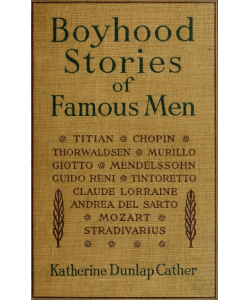Boyhood Stories of Famous Men

Author:
Katherine Dunlap Cather
Illustrator:
M.L. Bower
Publication:
1914 by The Century Co.
Genre:
Biography, History, Non-fiction
Pages:
278
Current state:
Basic information has been added for this book.
It is under consideration and will be updated when it is evaluated further.
Book Guide
Search for this book used on:
Once upon a time there was a little girl who journeyed very often into an enchanted valley. In it were rainbow-colored meadows, marvelous fruits and flowers and singing birds, and forests such as never grew in any country out of dreamland. Fairies and gnomes and sprites danced there by night, and along the crystal rivers of that land Merlin wrought his wizardry, bringing King Arthur and all his noble knights back to life again. There Sindbad the Sailor walked side by side with Robin Hood; there Aladdin carried his wonder lamp past the balcony where Juliet waited for Romeo; and there the children of Hamelin town, following the piper to the mountain gate, smiled at grave-eyed Carl making pictures by the Stove of Nuremberg. Richard Coeur de Lion and the crusaders rode over its shining highways as they moved toward Palestine, and several times Puck broke right through the procession, whereupon the Lion Heart had to re-marshal his forces before they could go on.
The whole great company of story folk gathered there, and the only way mortals could enter was to become acquainted with some member of the enchanted company who could lead them in. Thus, through the books she read and the tales she heard, the little girl came to know many a hero at whose beckoning the gates swung open, and she beheld the glories beyond them.But after a while she took no more journeys into the valley, for although she met many splendid book people, not one of them had the power to take her back. Instead of walking under spreading trees with the enchanted company, she had to stay in the world without, and live in the memory of beautiful days spent beyond the magic gates. Always, however, things seem to come out right, after all, for one morning between the covers of a dingy book, she found just what she had been seeking. In "The Child of Urbino," Ouida's lovely tribute to the great Raphael, was one who could take her into the rainbow country. The gates swung wide, and she went in again with the painter.
Years afterward, when she was grown, she still remembered and loved "The Child of Urbino," partly because of its beauty, partly because of all it had meant to her. It had shown her the way into a wonderful realm. It had caused her to realize that the stories of great creators are just as fascinating as those of Ali Baba, Sigurd the Volsung, the troubadours who sang in Provence, or the crusaders who fought in Pales-tine, and that by knowing them and their works the gates of the enchanted valley would never close to her. It taught her to look for the stories underlying great pictures and melodies; and, having found many, the thought occurred to her that she ought to share her treasures with boys and girls who would enjoy them.
So one day, under the magnolias of a California garden, she went to work, and out of that morning's record grew the story, "The Whittler of Cremona." A kindly editor liked it and asked for another, and thus "Boyhood Stories of Famous Men" came to be.
The facts that make up the tales have been gathered through many years and in many places, some from libraries in great American cities and universities, some from dusty manuscripts in museums and private collections across the sea, some from the lips of peasants who repeated legends handed down from the olden time. Most of them have already appeared in the St. Nicholas magazine; and now, through the pages of the book they come to you. May they lead you into the fascinating world of melody and color; may they open the magic gates for you just as that other story once opened them for me, into that rainbow country where delights are never ending.
From the Introduction
To view an example page please sign in.
Find This Book
Search for this book used on:


